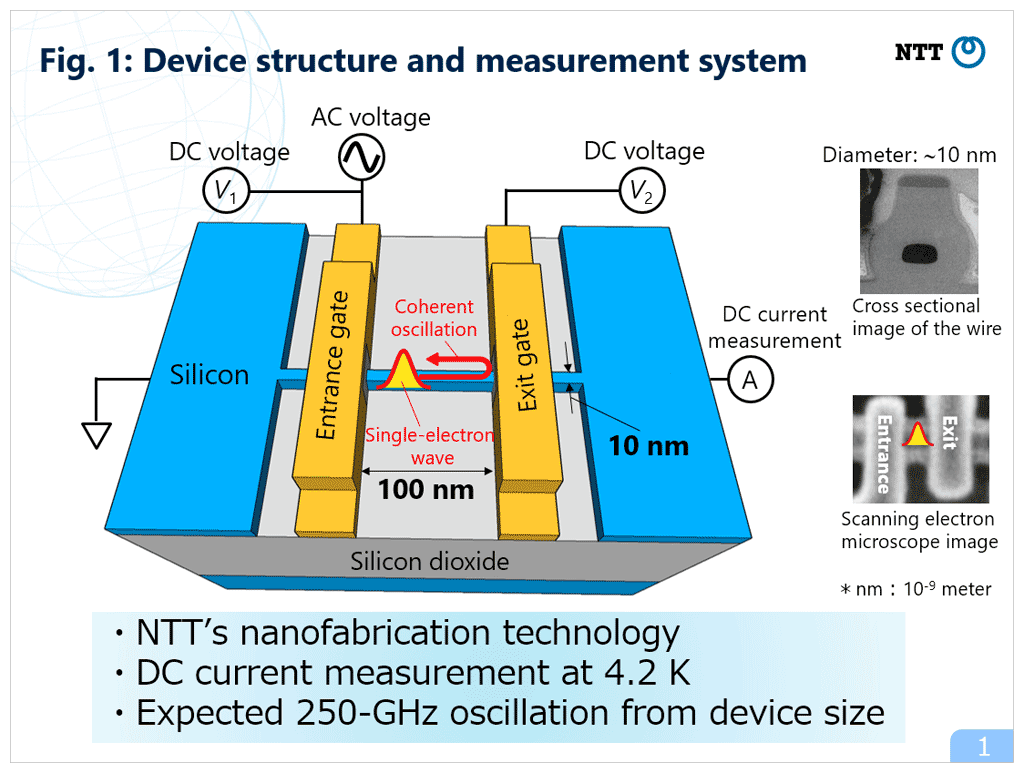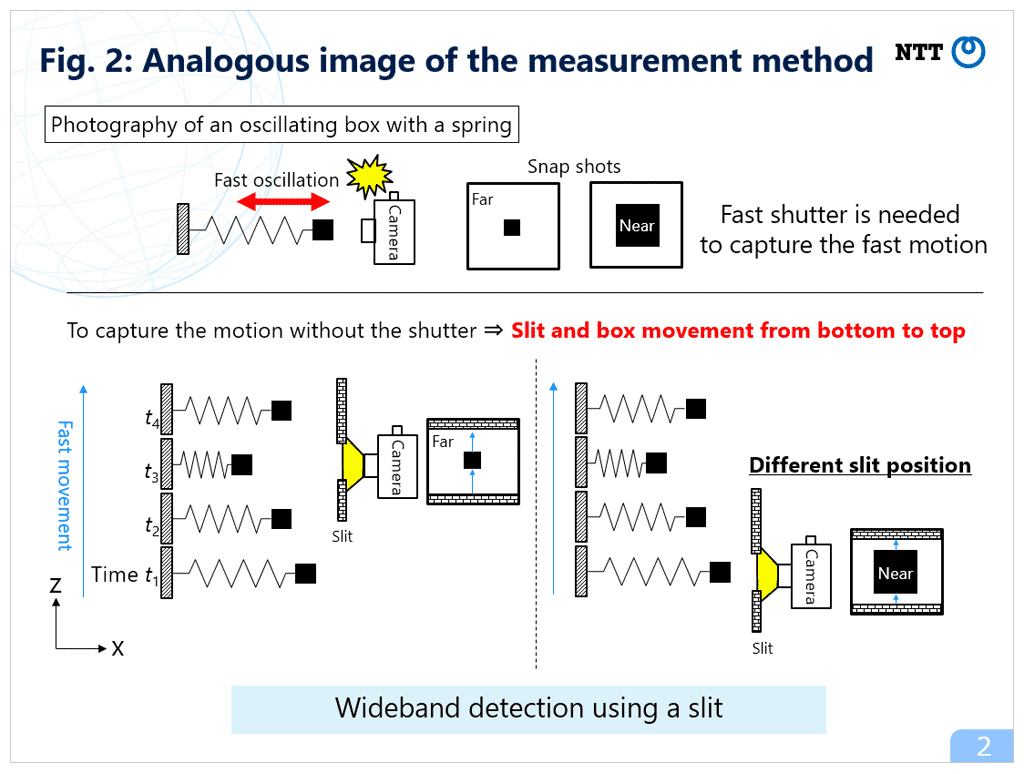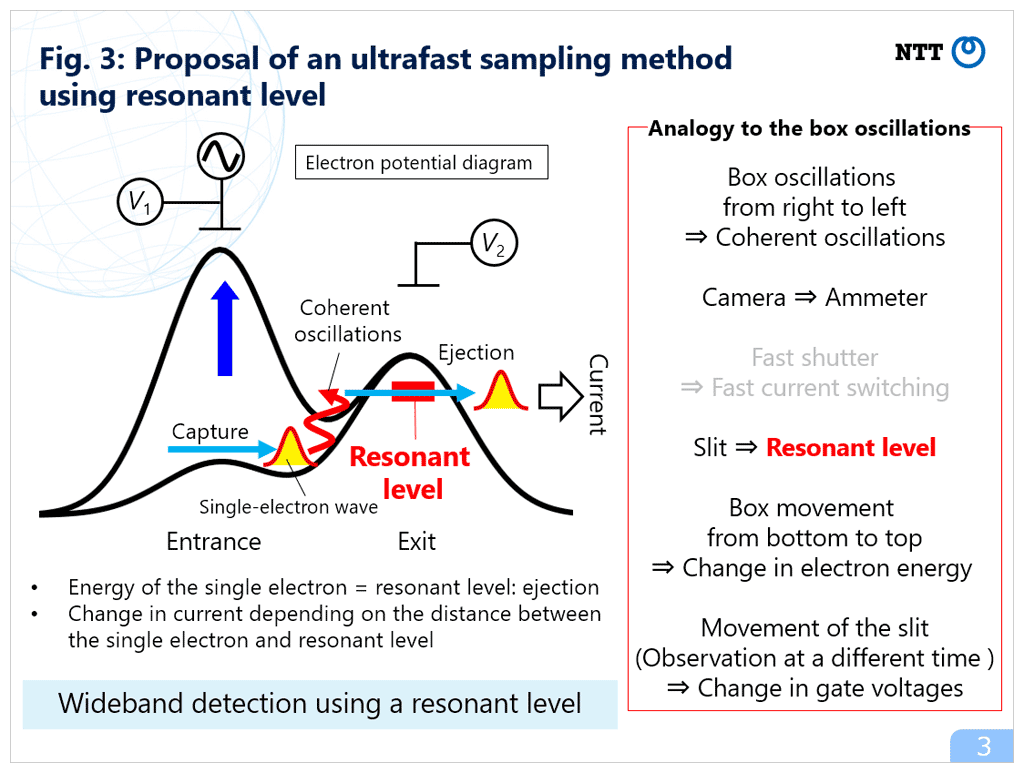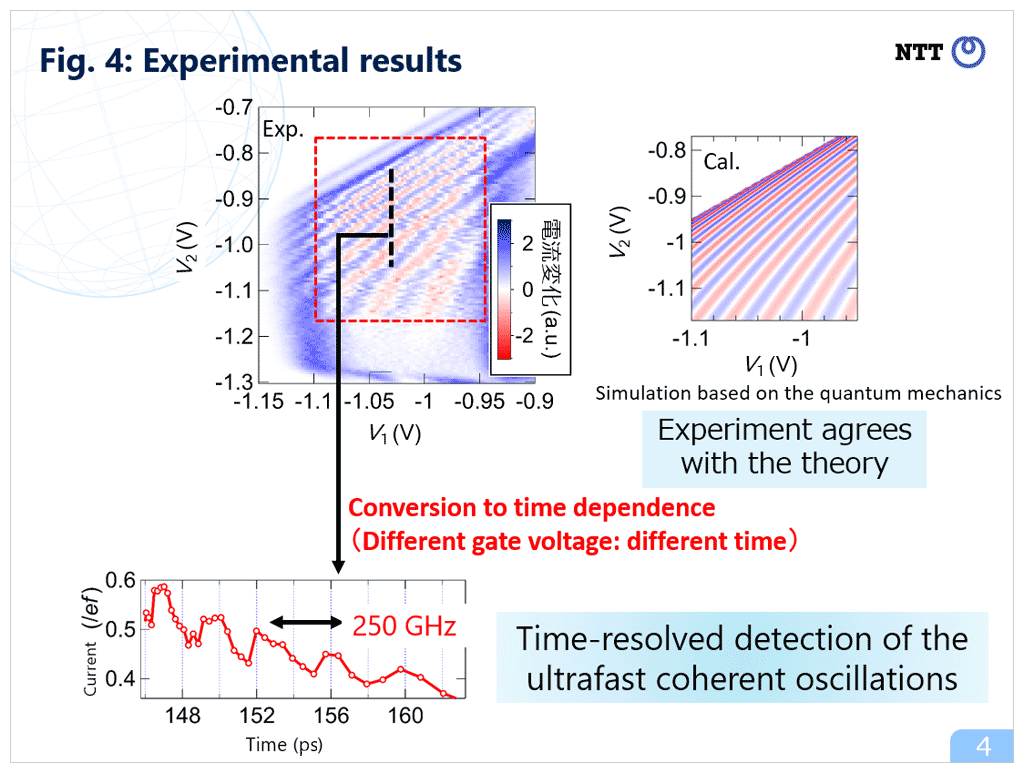Microsoft ends support for Internet Explorer on June 16, 2022.
We recommend using one of the browsers listed below.
- Microsoft Edge(Latest version)
- Mozilla Firefox(Latest version)
- Google Chrome(Latest version)
- Apple Safari(Latest version)
Please contact your browser provider for download and installation instructions.
November 5, 2019
Nippon Telegraph and Telephone Corporation
Korea Advanced Institute of Science and Technology
National Physical Laboratory
Observation of quantum-mechanical ultrafast coherent oscillations in a silicon single-electron device --Quantum behavior of a single electron in the sub-terahertz regime--
Nippon Telegraph and Telephone Corporation (NTT, Head office: Chiyoda-ku, Tokyo; President & CEO: Jun Sawada), Korea Advanced Institute of Science and Technology (KAIST) in Korea, and the National Physical Laboratory (NPL) in the UK have observed quantum-mechanical electron motion in silicon transistors*1 in the sub-terahertz regime, which is far in excess of the state-of-the-art measurement bandwidth. This indicates the enhancement of the detection speed and may lead to applications to ultrafast quantum-bit*2 operation and high-sensitivity electromagnetic-field sensing*3.
NTT has been studying single-electron manipulation using clock control in a nanoscale box formed in silicon transistors (the devices are referred to as single-electron transfer devices*4), to realize a high-accuracy current standard*5. In the previous works, we focused only on the particle nature of the electron. However, an electron also has a quantum-mechanical wave nature. This wave behavior and its applications have been theoretically discussed. In particular, when a wave of a single electron consists of a superposition of two different states, the electron is expected to move back and forth in the nanoscale box, which is referred to as quantum coherent oscillations*6. Since this motion can be faster than 100 GHz, it is hard to measure using existing measurement techniques.
In our international collaboration, we proposed a novel measurement method and succeeded in observing the time dependence of the ultrafast coherent oscillations in the sub-terahertz regime for the first time. In the experiments, we quantum-mechanically shuttle an electron in the box with varying electron energy. The electron transmits through the potential wall of the nanoscale box via a resonant energy level*7 in the wall due to quantum-mechanical tunneling*8. This happens when the electron is located close to the wall and its energy is aligned with the resonant level. By changing the elapsed time between the start of the oscillations and the transmission, we obtain the information about the oscillation period.
This work was published in the online version of "Nature Nanotechnology" on the 4th of November, 2019, and will be presented at "International school and symposium on nanoscale transport and photonics 2019" to be held by NTT from the 18th to 22nd of November. This work was partly supported by The Japan Society for the Promotion of Science.
1.Background
NTT has been studying single-electron transfer devices using silicon transistors and reported generation of high-accuracy current for application to current standards. In previous reports, we focused on the classical (particle) nature of electrons. On the other hand, electrons have a quantum-mechanical wave nature. It has been expected that the coherent oscillations of the electron wave can occur in single-electron transfer devices. The quantum computer*9, which utilizes these quantum effects, is extensively studied worldwide using superconductors, silicon, and other materials. Since the frequency of the electron coherent oscillations can exceed 100 GHz in single-electron transfer devices, it could be applied to ultrafast quantum-bit operation. However, the oscillations are hard to observe because the oscillation speed is far in excess of the bandwidth of the state-of-the-art measurement technique.
2.Achievements
We propose a novel method for detecting the ultrafast quantum coherent oscillations using a resonant level in a silicon single-electron transfer device. Using this method, we succeeded in observing the coherent oscillations with a frequency of about 250 GHz as the time dependence of the current. This method is expected to be used more generally to detect various ultrafast quantum phenomena of electrons, which was not possible until now. The contribution of the three institutes is as follows. NTT performed the fabrication of the device, NTT and NPL conducted the measurement of the device, and KAIST developed the theory of the coherent oscillations.
3.Technical features
(1)Ultrafast coherent oscillations in the single-electron transfer device
We fabricated two fine gate electrodes on a silicon nanowire using NTT's nanofabrication technique (Fig. 1). By applying a high-frequency AC voltage to the entrance gate electrode, a single electron is captured in the silicon nanowire between the gate electrodes and subsequently it is ejected to the exit side. During the capture stage, the electron can exist in a superposition state owing to the high-speed motion of the electron, and it can coherently oscillate. The frequency of the coherent oscillations is determined by the device size. In our device, this corresponds to ultrafast spatial oscillations with a frequency of about 250 GHz.
(2)Wideband detection using a resonant level
The new detection method is analogous to photography of a box oscillating from right to left with a spring using a camera located at the right side (Fig. 2). If the oscillations are fast, one needs a fast shutter in the camera. When the fast shutter is difficult to implement, it is valuable to use a slit in front of the camera and movement of the box from bottom to top. One can obtain information at a short time using this method because one can take a photo of the temporal movement of the box passing through the slit. Furthermore, information at a different time can be obtained by changing the location of the slit.
Here, we use a similar method in silicon nanoscale devices (Fig. 3). The oscillations of the box from right to left mentioned above correspond to the coherent oscillations. If one wants to observe the temporal position of the electron using measurements of a current (this corresponds to the photography), we need ultrafast switching of the current (this corresponds to the fast shutter). However, it is hard to achieve switching at a speed of higher than 100 GHz. Therefore, we use a resonant level, which corresponds to the slit mentioned above. Note that an electron can pass through the resonant level when the electron energy is aligned with the resonant level. In addition, the movement of the box from bottom to top mentioned above corresponds to the change in the electron energy in time due to application of the AC voltage. Since the ejection probability of the electron depends on how far the electron is located from the resonant level and the energy of the resonant level can be tuned by changing the gate voltage (this corresponds to the movement of the slit), we can extract the information at a different time by changing the gate voltage. In the experiment, we used the device that has a resonant level underneath the exit gate electrode and observed the ultrafast coherent oscillations as current oscillations (Fig. 4). This result agrees with the simulation based on the quantum mechanics, which supports the validity of the observation of the coherent oscillations. Furthermore, we achieved the conversion to the time dependence, indicating the time-resolved detection of the ultrafast coherent oscillations at about 250 GHz (Fig. 4).
4.Future plan
We will explore the possibility of ultrafast quantum-bit operation by using the detection method of the ultrafast coherent oscillations. In addition, we will also try quantum optics experiments*10 using electrons and explore the possibility of high-sensitivity electromagnetic field sensing. Furthermore, by investigating the mechanism of the high-speed single-electron transfer in detail using the detection of the coherent oscillations, we will improve the speed and accuracy of the single-electron transfer toward the application to current standards.
Publication information
Gento Yamahata, Sungguen Ryu, Nathan Johnson, H.-S. Sim, Akira Fujiwara, and Masaya Kataoka
"Picosecond coherent electron motion in a silicon single-electron source" Nature Nanotechnology (2019).




Glossary
*1Silicon transistors
These are devices fabricated using semiconducting silicon, which can switch or amplify electrical signals. In this work, we used field-effect transistors, which have the gate electrodes formed on silicon dioxide. The electric current flowing in silicon can be turned on or off by applying a voltage to a gate electrode.
*2Quantum bit (qubit)
This is a bit (basic unit) of the quantum computer, in which a superposition of two quantum-mechanical states (|0> and |1>) is used.
*3High-sensitivity electromagnetic-field sensing
In this work, this indicates novel sensing that uses the wave nature of electrons. For example, when a localized electron wave moves at a high speed, one can change whether the wave passes a certain region by changing an electric gate signal, which could detect a high-speed electric signal.
*4Single-electron transfer devices
These are devices that accurately convey an electron one-by-one. One can generate an extremely accurate current, which is only determined by the frequency of the input AC voltage and the elementary charge.
*5Current standards
These are standards for the base unit of electric current. The Ampere in the International System of Units (SI) was redefined on 20th May 2019 and is now realized using a current standard by fixing the value of the elementary charge e.
*6Quantum coherent oscillations
These are the oscillations occurring when the quantum-mechanical wave state of electrons evolves in time. This time evolution occurs when several wave states are superposed. Here, they correspond to the spatial oscillations of an electron in silicon. The oscillation frequency is determined by the energy level spacing of the electron confined to a small region.
*7Resonant energy level or resonant level
This is a quantum-mechanical state, through which an electron with a specific energy can pass.
*8Quantum-mechanical tunneling
This is a phenomenon with which a quantum-mechanical wave transmits across a potential wall, which a classical particle cannot do. Here, it corresponds to the quantum-mechanical transmission of an electron through a potential wall formed by applying the gate voltage.
*9Quantum computer
This is a computer using a superposition of two quantum-mechanical states (|0> and |1>). It is expected to solve specific problems much faster than a conventional computer.
*10Quantum optics experiments using electrons
Quantum optics is a research field studying and utilizing the quantum-mechanical nature of light. Since the light and electron have wave-particle duality but the detailed characteristics are different, the electronic version of the experiments performed previously with light is of great interest.
Contact information
Nippon Telegraph and Telephone Corporation
Science and Core Technology Laboratory Group, Public Relations
Tel:046-240-5157
E-mail: science_coretech-pr-ml@hco.ntt.co.jp
Information is current as of the date of issue of the individual press release.
Please be advised that information may be outdated after that point.
NTT STORY
WEB media that thinks about the future with NTT










